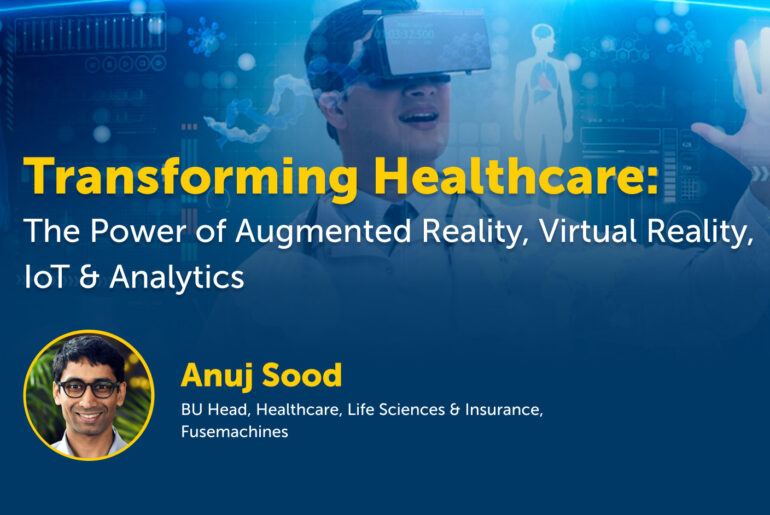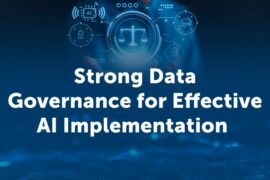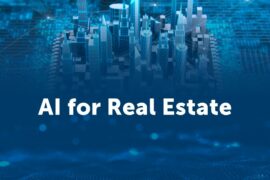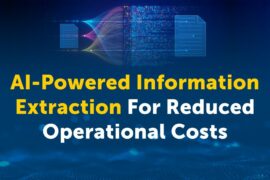Healthcare leaders are grappling with several novel challenges, from evolving patient expectations and rising costs to increasing demands for care in aging populations. The industry is simultaneously witnessing a remarkable revolution powered by cutting-edge technologies such as AI, augmented reality (AR), virtual reality (VR), the Internet of Medical Things (IoMT), and analytics capabilities.
Let’s take a closer look at the driving forces behind this revolution. This blog will discuss how these technologies are reshaping healthcare as we know it. We also provide insights on how healthcare executives and decision-makers can leverage them to gain a competitive edge and stay ahead in the market.
Table of contents
The Data Explosion in Healthcare
The healthcare industry generates approximately 30% of the world’s data. By 2025, the annual growth rate of healthcare data will be 36%, 6% faster than manufacturing, 10% faster than financial services, and 11% faster than media and entertainment.
This explosion of data in healthcare is largely due to advancements in electronic health records (EHRs), health monitoring devices, and the Internet of Medical Things (IoMT). EHRs contain information on patient medical history, diagnoses, medications, treatment plans, immunization dates, and more. Wearable health monitors and IoMT devices generate data on vital signs, activity levels, and other health metrics.
Artificial intelligence (AI) and machine learning (ML) are being applied to derive meaningful insights from huge healthcare datasets and improve patient outcomes. AI can detect patterns in data that humans may miss and gain actionable insights to enable precision medicine, reduce costs, and enhance the patient experience. ML algorithms learn directly from data, detecting complex relationships and patterns to make predictions or decisions without being explicitly programmed.
Some examples of how AI and ML are being used in healthcare include:
- Diagnosing diseases and conditions: AI systems analyze medical scans, diagnostic test results, symptoms, and other patient data to detect signs of diseases like cancer, eye diseases, or pneumonia.
- Personalizing treatment plans: By analyzing a patient’s medical history, genes, lifestyle, and other individual patient factors, AI can help determine the optimal treatment plan based on their unique needs and circumstances.
- Reducing hospital readmissions: ML models can identify patients at high risk of being readmitted so intervention measures can be taken to avoid readmission.
- Enhancing utilization management and patient triage: AI swiftly identifies the urgency of cases through advanced algorithms and real-time data analysis, enabling timely and appropriate care allocation and improving healthcare outcomes.
- Automating administrative tasks: AI drives automation in healthcare by leveraging natural language processing and machine learning algorithms to streamline administrative tasks, including intelligent appointment scheduling, accurate billing code generation, and automated insurance claim processing. This reduces the burden on administrative staff, minimizes errors, enhances precision, and ultimately contributes to cost reduction and improved operational efficiency.
- Enhancing drug discovery: Advanced AI techniques accelerate drug discovery and enhance pharmacovigilance by analyzing vast datasets for potential drug interactions and adverse reactions. It streamlines molecule screening, identifies promising compounds, and expedites literature reviews, providing valuable insights for researchers. This multifunctional use of AI revolutionizes drug development, safety monitoring, and information synthesis in healthcare.
Click here to explore the how Fusemachines transforms healthcare businesses with its expert AI solutions. To schedule a complimentary consultation today, click here.
Immersive Visualization: How AR and VR Are Revolutionizing Medical Imaging and Education
Augmented reality (AR) and virtual reality (VR) are transforming the way medical practitioners visualize and comprehend complex anatomical structures. AR enhances what physicians see by overlaying digital information in the real world, whereas VR transports them into a completely simulated environment.
AR and VR are enhancing medical imaging through various optimizations:
- AR permits surgeons to view patient scans, like CT or MRI, as 3D holograms directly on the body during procedures. This increases precision and reduces errors. For instance, surgeons can see blood vessels beneath the skin surface with AR.
- VR allows physicians to explore detailed 3D reconstructions of patient anatomy. Doctors can identify anomalies easily and determine an optimal treatment path. VR also enables remote collaboration where surgeons across locations can jointly review and discuss cases.
- AR and VR elevate comprehension of complex physiological interactions and disease processes by offering interactive 3D simulations and visualizations. This accelerated learning translates into improved diagnostic skills for healthcare professionals, ultimately positively impacting patient outcomes.
Additionally, AR and VR are revolutionizing medical education and training:
- Students can engage in virtual dissections, practice complex techniques like suturing, and role play difficult conversations with patients, all through immersive experiences.
- Residents can rehearse high-risk procedures in a controlled VR environment, building confidence and muscle memory prior to performing surgeries. This results in improved performance and patient safety.
- Continuing education through AR/VR is more engaging and effective. Doctors can stay up-to-date with the latest techniques and information through self-paced immersive courses.
Click here to explore the how Fusemachines transforms healthcare businesses with its expert AI solutions. To schedule a complimentary consultation today, click here.
Connected Care: The Role of IoMT in Remote Monitoring, Diagnostics and Improved Outcomes
The Internet of Medical Things (IoMT) specifically refers to the integration and connectivity of medical devices and applications within the broader framework of the Internet of Things (IoT). In healthcare, IoMT involves using smart, interconnected medical devices and systems that can collect, exchange, and analyze health data. These devices include wearable fitness trackers, smart medical sensors, remote monitoring devices, and other healthcare-related technologies.
Connected care improves health outcomes by detecting changes in a patient’s condition early. Continuous monitoring enables providers to identify warning signs sooner and adjust treatment plans immediately. For patients with chronic conditions like diabetes, heart disease, or COPD, connected care can reduce complications and speed up recovery. Studies show a 50% drop in readmission rates for heart failure patients using remote monitoring.
Diagnostics also benefit from IoMT connectivity. Smart devices can detect slight changes in a patient’s vital signs or symptoms and alert physicians. Machine learning algorithms analyze data streams from multiple devices to identify patterns and predict health events. Wearable monitors track metrics like blood pressure, glucose levels, respiration, and temperature.
Telemedicine leverages IoT devices for virtual consultations. Patients in remote areas can connect with medical specialists without travel. Providers can evaluate patient health data, discuss symptoms, and adjust medications during a video call. High-risk patients with conditions like cancer can get more frequent monitoring through telemedicine.
AI plays a vital role in unlocking the full potential of IoMT, by interpreting vast health data through advanced algorithms. AI enhances IoMT devices, enabling predictive analytics for proactive healthcare interventions and personalized treatment plans. This synergy not only ensures more accurate diagnostics but continually improves predictive models for effective patient care.
IoMT combined with analytics and AI delivers cost savings as well as improved health outcomes through complication prevention, broadened access in remote and underserved areas, and ensures rapid diagnoses and alerts for a swift healthcare response. When deployed responsibly, IoMT and connected care offer life-changing benefits for improved population health and patient experiences. The future of healthcare will depend on secure connectivity and how we leverage the data generated by humans and IoMTs.
Click here to explore the how Fusemachines transforms healthcare businesses with its expert AI solutions. To schedule a complimentary consultation today, click here.
Insights at Scale: Harnessing the Power of Data for Precision Medicine
The increasing volumes of data in healthcare require advanced tools to gain insights and enable precision medicine. Data analytics leverages artificial intelligence and machine learning to uncover patterns in large datasets that would otherwise be nearly impossible for humans to perceive. When applied to healthcare, data analytics has the potential to transform medical research and improve patient outcomes through precision medicine.
Enabling Precision Medicine
Precision medicine relies on sophisticated genomic data analysis techniques, particularly through bioinformatics tools and algorithms. These technologies are instrumental in interpreting genetic information, pinpointing mutations, and tailoring treatment plans to individual patients. Additionally, real-time data integration, including information from Electronic Health Records (EHRs) and wearable devices, ensures healthcare providers have the most current and comprehensive patient insights for informed decision-making.
Advancing Medical Research
The advancement of medical research is accelerated by data-centric technologies such as machine learning for pattern recognition. These machine learning algorithms efficiently analyze vast datasets, unveiling patterns and correlations that might take years for human researchers to identify. Data mining techniques play a crucial role in extracting valuable insights from extensive datasets, aiding researchers in discovering disease subtypes, biomarkers, and potential therapeutic targets at an accelerated pace.
Improving Diagnostics and Treatment
Predictive analytics is pivotal in improving diagnostics and treatment plans by forecasting potential health risks based on patient data. This allows for early intervention and the development of personalized treatment strategies. Clinical Decision Support Systems, driven by data-driven algorithms, assist healthcare professionals in making evidence-based decisions by analyzing patient data, medical literature, and established best practices. Population health analytics, which involves analyzing aggregated data from large populations, provides valuable insights into trends, healthcare outcomes, and informs strategies for enhancing overall public health.
Bottom Line
The path forward is clear for healthcare leaders and decision-makers. Take steps now to implement artificial intelligence, virtual and augmented reality for training, IoMT for remote monitoring, and data analytics for insight. Your patients’ health and your organization’s sustainability depend on it. The future of healthcare is technology-enabled, value-based, and patient-centered. Lead the way.
Click here to explore the how Fusemachines transforms healthcare businesses with its expert AI solutions. To schedule a complimentary consultation today, click here.







